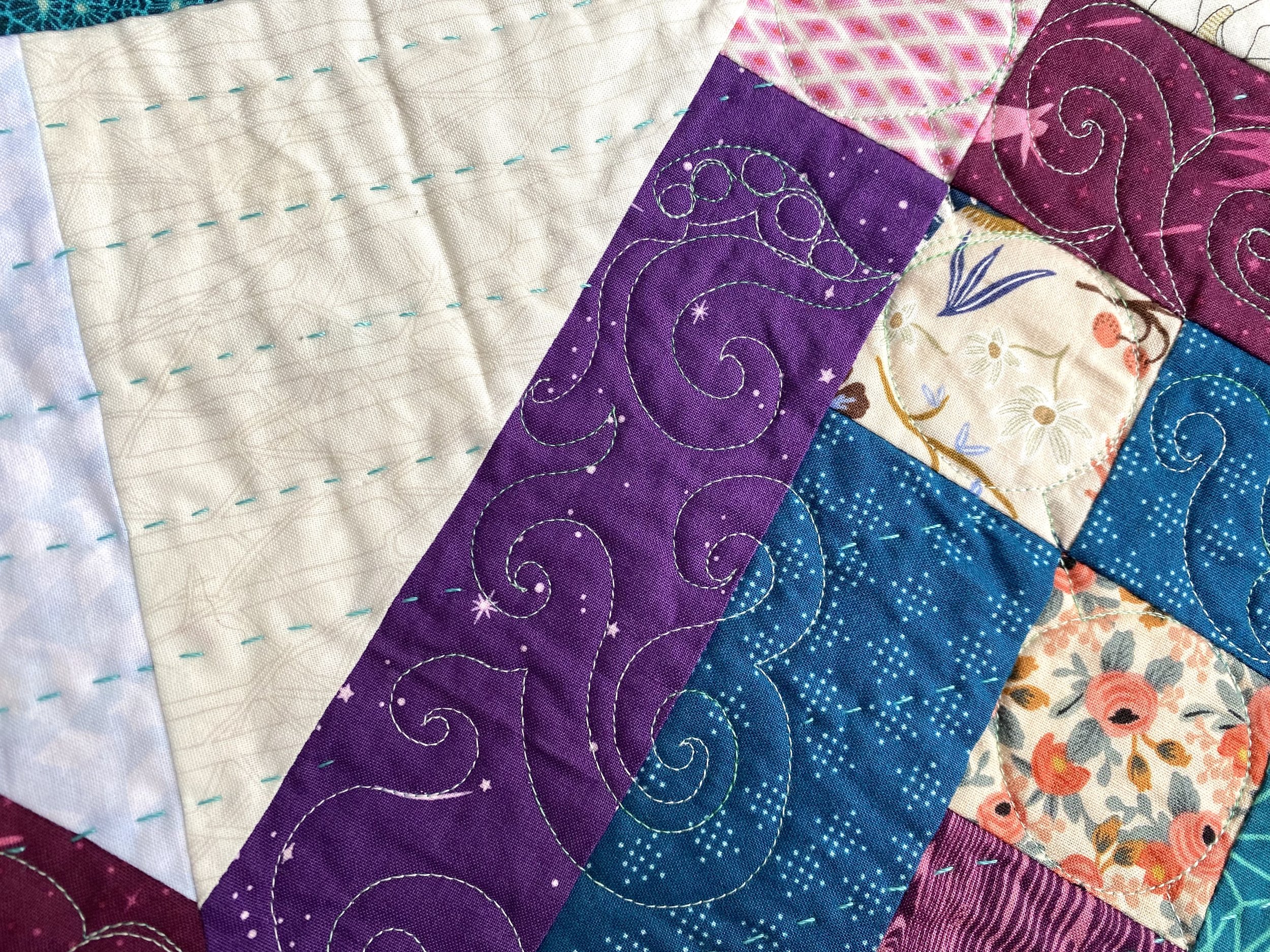Hand and Machine: Quilting that Complements Itself.
This month’s Aurifil Artisan project is about using hand quilting and machine quilting together.
Most of the time when I’m finished piecing, I make the decision to either hand quilt or machine quilt. And most of the time I choose to machine quilt. Sometimes the quilt “wants” to be hand quilted.
My shibori dyed quilt, with 12wt hand quilting.
But sometimes the answer is “both”.
I love combining lots of fabrics in unexpected ways, so why not combine stitches like that?
Machine quilting, whether free motion or straight line, is typically identified by stitches that are close together with no gaps between.
Hand quilting typically has a little space in between stitches. This is where the thread is on the back of the quilt (completing the stitch) or sometimes traveling through the layers of the quilt.
I’m ok with my hand quilting stitches to not be “perfect”. Hand quilting for me is about experiencing the process.
I tend to use a 50wt Aurifil thread for piecing and machine quilting, and 12wt for hand quilting. I love the thick thread for larger stitches, and how they stand out. (The smaller the number, the thicker the thread.)
50wt Aurifil thread is on the left and 12wt Aurifil thread is on the right.
You might find yourself using both kinds of quilting if you baste with a machine, then go in and add hand quilting later. I did this with my “Pop” quilt. The pattern is the Kinship 100 Block Fusion Sampler by Angie at Gnome Angel, and I used all “Pop” fabric by Rashida Coleman-Hale.
This might be the “busiest” quilt I’ve ever made, but I completely love it.
I combined fabric selvages on the pieced back. I love doing this for fun, but also as a record of the fabric used and what year it was made.
I wanted to hand quilt all of it, but I didn’t want to be messing with pins. And I knew it would take me a while to hand quilt it, so I needed some quilting in place to hold things steady for me as I took my time.
Because it’s “in the ditch”, the machine quilting is easier to see on the back of the quilt.
I ended up quilting a wide grid, going between the blocks on the front. Once it was done, I knew things would stay in place and I could take my time to hand quilt. This was essentially hand quilting with a machine assist.
I had fun playing with pattern matching in this quilt - the bottles were especially enjoyable to work with.
You might want to use both machine and hand quilting on the same quilt for texture or appearance. Hand quilting can emphasize what’s there.
I made this quilt super scrappy, using the Kitchen Sink Quilt pattern by Karoline Li. I knew I wanted to hand quilt some of it while also doing some free motion quilting. So when I quilted it I left intentional spaces that I could go into later with hand quilting.
If you do this, make sure your spacing between quilted lines isn’t so far apart that the quilt is at risk structurally. I pushed it to the limit of the recommended quilt spacing on the batting I was using.
I wanted to take this quilt camping with me to hand quilt by the fire - so I went ahead and bound it (so no dirt or debris would make its way into the layers of the quilt sandwich). And if I’m being completely honest here (which I always try to be), I never actually finished it!
Open space left in the quilting - room for me to come in with hand quilting later.
This is my favorite part about hand quilting - you can always add more later! You don’t need to start and stop outside the edges of the quilt. I knot and bury my threads so the tails are hidden within the quilt, and travel the needle between the layers of the quilt to move around.
I love playing with the different ways to use and combine thread. I want to start hand quilting with thinner thread (50wt), and using more layers of thread on top of each other. There is so much to explore here, and so many amazing combinations to try.















